There are 62 Lizards in Florida in this list with only 21 actually being native to the region. Florida has a variety of forests, woodlands, swamps, grasslands, prairies, and scrub desert habitats, which are perfect for the various lizard species.
Those invasive to the state may have a specific range where are found. Lizards can even be seen in urban areas near homes, and man-made buildings. Learning about the lizards that live in the state can help you find, and identify the ones you come across.
Some differences in the lizard species in Florida include their appearance, behavior, and the habitats they prefer to live. Let’s look at the 62 species you may find in Florida, and the amazing things to learn about them.
Table of Contents
Lizards in Florida
Agamidae
1. Common Agama

- Experience Level: Intermediate
- Family: Agamidae
- Scientific Name: Agama agama
- Other Names: Rainbow Agama, Red-headed Rock Agama
- Adult Size: 5 to 11.8 in. (13 to 30 cm.)
- Lifespan: 10 to 30 years
- Average Price Range: $20
The common agama is native to the east, and west Africa. This species is invasive to Florida and managed to establish itself in the southern, to northern portions of the state. Common agamas live in arid, and humid habitats. They are active during the day and can endure high temperatures.
Common agamas have a white belly, but a colorful appearance. They have a stripe that runs down their side. Tan is a common color this species appears in, but males can have color, and have a blue body, with an orange head.
Insects and small mammals are what this species eats, but they also feed on fruits and other vegetation. The common agama can be territorial with other lizards in the breeding season, as males are competitive. Females lay between 5 to 7 eggs yearly, and these lizards are mainly seen in urban areas.
2. Oriental Garden Lizard

- Experience Level: Intermediate
- Family: Agamidae
- Scientific Name: Calotes versicolor
- Other Names: Changeable Lizard, Bloodsucker Lizard
- Adult Size: 3.9 to 14.5 in. (10 to 37 cm.)
- Lifespan: 5 years
- Average Price Range: $30
Oriental garden lizards are native to the Middle East, and Asia. This species has been introduced to the United States, including Florida. Open habitats with lots of vegetation, and urban areas are where this lizard lives.
In the breeding season, males of this species have bright red coloring. This lizard has a very slender body and a long tail. They have green, brown, olive, black, or red coloring. The scales of this lizard are roughly keeled, and they have spines on the center of their back. They are able to change their color to help them better blend into their environments.
This lizard feeds on crickets, ants, and other insects. They can even eat other lizards like geckos, or small mice. When breeding this lizard can lay up to 20 eggs, which take around 6 to 7 weeks to hatch.
3. Common Butterfly Lizard

- Experience Level: Intermediate
- Family: Agamidae
- Scientific Name: Leiolepis belliana
- Other Names: Butterfly Agama
- Adult Size: 5.9 in. (15 cm.)
- Lifespan: 8 years
- Average Price Range: $35
The common butterfly lizard is native to Thailand, Vietnam, Cambodia, Indonesia, and Myanmar. This lizard lives in moist forest habitats. They are common in sandy coastlands, and in agricultural fields. Common butterfly lizards have become invasive in Florida due to the pet trade.
Common butterfly lizards have a greenish, or gray coloring. They have black, blue, orange, and yellow markings on their body. This lizard is medium-sized, and its skink is very wrinkly.
The species name of this lizard is named in honor of Thomas Bell, the English zoologist. This lizard feeds on grasshoppers, butterflies, and other insects. They burrow when laying eggs, and can lay anywhere between 3 to 8 eggs. It is not known the impact this invasive species has done on Florida, since they are not common.
4. Red-banded Butterfly Lizard

- Experience Level: Intermediate
- Family: Agamidae
- Scientific Name: Leiolepis rubritaeniata
- Other Names: n/a
- Adult Size: 5.9 in. (15 cm.)
- Lifespan: 8 years
- Average Price Range: n/a
The red-banded butterfly lizard is a newer invasive species in Florida. This lizard is native to Thailand, and other nearby countries. Coastal and urban habitats are where this species lives.
Red-banded lizards get their name from the red marking that appears on their sides. Yellowish and white spots also appear on them. They have a gray, or olive appearance. Males are able to flatten their bodies to better show off their color.
Not much is known about this lizard’s range in Florida, and they are very rare to come across. They feed on larvae, insects, spiders, and other invertebrates.
Teiidae
5. Giant Whiptail

- Experience Level: Intermediate
- Family: Teiidae
- Scientific Name: Aspidoscelis motaguae
- Other Names: n/a
- Adult Size: 2.75 to 5.24 in. (6.9 to 13.7 cm.)
- Lifespan: 7 years
- Average Price Range: n/a
The giant whiptail is a lizard native to Mexico, Honduras, Guatemala, and Nicaragua. This species is invasive to the United States and is one lizard that lives in Florida.
Giant whiptails have long bodies and tails. They have yellowish spots, with a pointed snout, and robust bodies. Tan to grayish is the color these lizards appear in, and they have a white underside.
The pet trade is one of the main reasons the giant whiptail has become invasive to Florida. While an invasive species, when young and in the breeding season this lizard can showcase beautiful colors.
6. Giant Ameiva

- Experience Level: Intermediate
- Family: Teiidae
- Scientific Name: Ameiva ameiva
- Other Names: Amazon racerunner, Green Ameiva
- Adult Size: 18 to 20 in. (45 to 50 cm.)
- Lifespan: 4.6 years
- Average Price Range: $50
Giant ameiva is native to South, and Central America. This species has been introduced to Florida. They live in forests and savanna habitats. Ameiva lizards were first reported in the United States in the 1950s, and they escaped in the wild from the pet trade. Giant ameiva has managed to establish a population within the state.
This lizard has a long and thick body. They have tan to green coloring with a mottled pattern covering them. Giant ameiva that are male have brighter coloring of green. The tongue of this species is forked, and their heads are pointed.
Insects like butterflies, roaches, and smaller lizards are what this species eats. The bright color this species portrays is why many consider getting this species as a pet. Spring to fall is when this lizard breeds, and lay their eggs.
7. Six-lined Racerunner
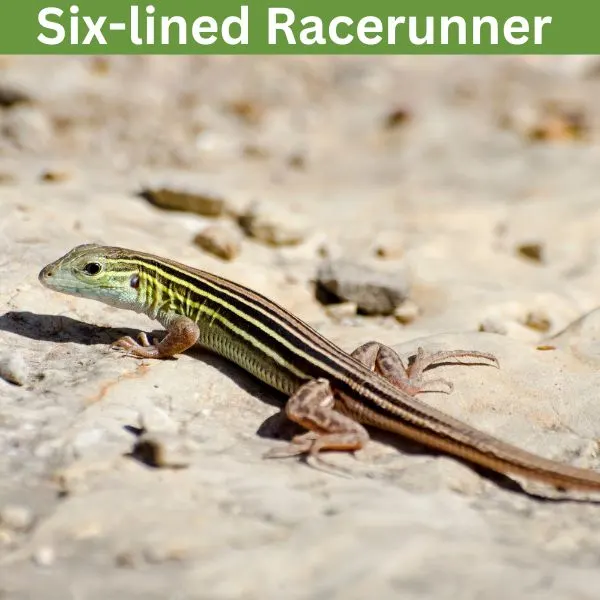
- Experience Level: Intermediate
- Family: Teiidae
- Scientific Name: Aspidoscelis sexlineata
- Other Names: Sandlapper lizard
- Adult Size: 6 to 9.5 in. (15 to 24 cm.)
- Lifespan: 4 to 5 years
- Average Price Range: $30
Six-lined racerunners are native to Florida. This lizard is found across the southeastern United States, and even in Mexico. Grasslands, woodlands, floodplains, and rocky habitats are where this lizard lives.
Dark green, brown, or black are the colors this lizard appears in. Six yellow, or orange stripes run down their back, and they have specks that appear on them. This lizard has long toes, and their heads are small and rounded.
Six-lined race runners are active during the day and spend their time feeding on insects. They are active mostly in the morning until noon. They can run up to 18 mph. (29 kph.), which is helpful for escaping predators. This lizard has a stable population, but in some regions, they are on the decline.
8. Dusky Giant Ameiva

- Experience Level: Intermediate
- Family: Teiidae
- Scientific Name: Ameiva praesignis
- Other Names: Dusky Giant Ameiva
- Adult Size: 18 to 20 in. (45 to 50 cm.)
- Lifespan: 4.6 years
- Average Price Range: n/a
South America in Costa Rica, Panama, Venezuela, and Colombia is where the Borriguero ameiva lives. This species has been introduced to Florida, and it is very rare to come across this lizard in the state.
This lizard species has a large head, with gray, or olive coloring. They have spots, and stripes on them, and very long toes. This species is terrestrial and typically active during the day.
It is not known whether this lizard has managed to establish a large population in Florida, but this species likely came into the state because of the pet trade.
9. Rainbow Whiptail

- Experience Level: Intermediate
- Family: Teiidae
- Scientific Name: Cnemidophorus lemniscatus
- Other Names: n/a
- Adult Size: 12 in. (30.5 cm.)
- Lifespan: 4 years
- Average Price Range: $30
Rainbow whiptails lizards are native to Central America, and the Caribbean. This lizard is one that was introduced to Florida and has become invasive to the state. Sandy beaches, and edged forest habitats are where this lizard lives. They prefer places with lots of water sources.
Rainbow whiptails are medium-sized lizards. They have bright green coloring, with a blue underside, and yellow spots on them. A mid-dorsal stripe appears down their center, and they have triangular-shaped heads.
This lizard is able to reproduce asexually, which is why they have become invasive to many areas. They have a stable population and are sometimes kept as pets by intermediate reptile owners.
10. Argentine Black and White Tegu

- Experience Level: Intermediate
- Family: Teiidae
- Scientific Name: Salvator merianae
- Other Names: Huge Tegu
- Adult Size: 2.5 to 4.5 ft. (76.2 to 137 cm.)
- Lifespan: 20 years
- Average Price Range: $200
The Argentine black and white tegu is an invasive lizard in Florida. This species is native to South America. Savannas and forest habitats are where this species lives. While a terrestrial species, they are able to swim and climb. As an invasive species, this lizard is not protected, as they can prey on Florida’s native species.
Black and white in color, this tegu species is large and can reach up to five feet. This lizard has a banded pattern across its back and tail. Tegus have greenish coloring, and heads when born.
This lizard is an omnivore, feeding on things like plants, insects, eggs, and fruit. Argentine black and white tegus hibernate in burrows in the winter, and you may see them emerging in February. Tegus are often kept as pets by some. Their size and extensive care are why this lizard is abandoned in the wild.
Dactyloidae
11. Green Anole
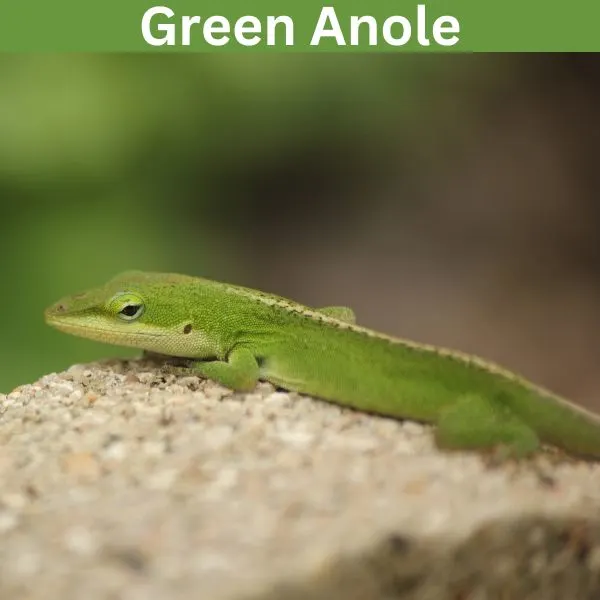
- Experience Level: Beginner
- Family: Dactyloidae
- Scientific Name: Anolis carolinensis
- Other Names: American Anole, Red-throated Anole
- Adult Size: 4.9 to 8 in. (12.5 to 20.3 cm.)
- Lifespan: 5 to 8 years
- Average Price Range: $10
The green anole is one of the native lizards that live in Florida. This lizard is found all across the state, and the southeastern United States. Grasslands, woodlands, swamps, and other places with high humidity are where this lizard is common. Green anoles have a stable population, but the introduction of other lizards to their region may cause their decline.
Green anoles have a long and slender body, with a pointed heads. They have a dewlap on their chin, and males can have reddish, or pink coloring under their chin. Green anoles can change their color to better match their environment. Tan, gray, or green are the most common colors they appear in.
Insects, spiders, and plant material is what the green anole eats. Active during the day, you can often see this species basking in the sun for warmth. At night they sleep in plant life, and in winter they go underground for hibernation.
12. Hispaniolan Green Anole

- Experience Level: Intermediate
- Family: Dactyloidae
- Scientific Name: Anolis chlorocyanus
- Other Names: Hispaniolan Green Anole
- Adult Size: 4.9 to 8 in. (12.5 to 20.3 cm.)
- Lifespan: 5 to 8 years
- Average Price Range: n/a
The Tiburon green anole is native to Haiti, and the Tiburon Penisula. This lizard has been introduced to Florida and Suriname in South America. Costal, and valley habitats are this lizard’s natural habitat, but they have managed to live in Florida.
Tiburon green anoles have green coloring, with a pointed head. A stripe runs down this species’ side, and they have a dewlap under their chin. This species’ size and behavior are similar to the green anole native to Florida, but the Hispaniolan green anole has a blue dewlap instead of blue.
13. Large-headed Anole

- Experience Level: Intermediate
- Family: Dactyloidae
- Scientific Name: Anolis cybotes
- Other Names: Hispaniolan Stout Anole
- Adult Size: 2.2 to 3.1 in. (5.7 to 7.9 cm.)
- Lifespan: 10 years
- Average Price Range: n/a
The large-headed anole is a species native to Haiti, in the Tiburon Penisula. This species has been introduced to Florida and has managed to build a small breeding population.
The large-headed anole is named after the male’s larger heads. This lizard has tannish coloring, with a stripe on their side. The dewlap of this lizard under their chin is orangish, or yellow. The larger head of this lizard is their most identifiable trait, and they have roughly keeled scales.
14. Bark Anole

- Experience Level: Intermediate
- Family: Dactyloidae
- Scientific Name: Anolis distichus
- Other Names: North Caribbean Bark Anole
- Adult Size: 5 in. (12.7 cm.)
- Lifespan: 5 years
- Average Price Range: n/a
The bark anole is a lizard native to the island of Hispaniola, and the Bahamas. This lizard has been introduced to Florida, and it was first seen in the state in 1946. Near the Miami, area, and other cities are where this lizard is commonly found. They enjoy climbing and are often seen in trees.
Barn anoles are a lizard that comes in various colors, and there are lots of subspecies of this lizard. Brown, tan, gray, and green and their most common shade. This lizard has a red dewlap with a yellow edge. They are a small species and one of the many types of invasive lizards in Florida.
15. Knight Anole

- Experience Level: Intermediate
- Family: Dactyloidae
- Scientific Name: Anolis equestris
- Other Names: Cuban Giant Anole
- Adult Size: 13 to 20 in. (33 to 51 cm.)
- Lifespan: 6 years
- Average Price Range: $15
Knight anoles are a lizard that is introduced to the state of Florida. This species is originally native to Cuba but has managed to create a population in the United States. Knight anoles live in woodlands, mangroves, and savanna habitats.
This lizard is large and has bright green coloring. They have a yellow stripe on their side and a dewlap pink in color. Knight anoles can change their shade to better camouflage in their habitat.
These lizards are active during the day and spend their time looking for insect food to eat. Knight anoles are sometimes kept in captivity and can be tamed if handled from a young age.
16. Jamaican Giant Anole

- Experience Level: Intermediate
- Family: Dactyloidae
- Scientific Name: Anolis garmani
- Other Names: Jamaican Anole
- Adult Size: 3.9 to 5.2 in. (10 to 13 cm.)
- Lifespan: 8 years
- Average Price Range: $150
The Jamaican giant anole is native to Jamaica. This species is one of many anoles introduced to Florida, but they have been spotted in other parts of the United States like the grand canyon region.
This lizard is large, with dark brown, or tan coloring. They have dewlaps under their chins, and stripes appear on their body. The head of this species is pointed, and bumpy scales appear on their bodies.
The Jamaican anole’s species name is in honor of American herpetologist Samuel Garman. This lizard is not native to Florida and is a threat to the native species of the state.
17. Brown Anole

- Experience Level: Intermediate
- Family: Dactyloidae
- Scientific Name: Anolis sagrei
- Other Names: Cuban Brown Anole
- Adult Size: 5 to 8.5 in. (12.7 to 21.59 cm.)
- Lifespan: 5 years
- Average Price Range: $5
The brown anole is native to Cuba, and the Bahamas. This lizard has been introduced to Florida, and other regions within the United States like Texas, Tennessee, and Georgia. Brown anoles are very invasive, and are thought to have come to the state in early 1970s.
Brown anoles are named after their color, which is tan, to brown. This species has the ability to change colors, and they have a mottled pattern on them. There is a dewlap under their chin, which has orange coloring.
Brown anoles feed on insects like ants, moths, grasshoppers, and worms. This species mates in the warmer season of the eyar, and can lay up ot 18 eggs. Brown anoles can easily blend into habitats, which make it harder for predators to feed on them.
18. Saint Vincent’s Bush Anole

- Experience Level: Intermediate
- Family: Dactyloidae
- Scientific Name: Anolis trinitatis
- Other Names: Trinidad Anole
- Adult Size: 3 in. (7.4 cm.)
- Lifespan: 5 years
- Average Price Range: n/a
The Saint Vincent bush anole is native to the Caribbean. This species is one that has been introduced to Florida. They get their name from the island of Saint Vincent which they are found in the Caribbean.
This lizard has green, to greenish-blue coloring. They have a pointed head with large jaws. Males like other anoles have a dewlap that is large and colorful.
In trees perched onto branches are where this lizard is often seen. Because of their limited numbers, this species is not seen often in Florida, and they are often confused for other anoles.
Corytophanidae
19. Brown Basilisk

- Experience Level: Intermediate
- Family: Corytophanidae
- Scientific Name: Basiliscus vittatus
- Other Names: Striped Basilisk
- Adult Size: 24 in. (61 cm.)
- Lifespan: 8 years
- Average Price Range: $35
Mexico and Central America are where the brown basilisk lizard is native. This species has been introduced to Florida and has a breeding population. Brown basilisks live in woodland habitats. They are able to walk on their hind legs, and can even turn on the water without sinking.
The male brown basilisk is able to grow larger than females. This lizard has a tan, or brown coloring, with dark crossbands appearing on them. Brown basilisks have a dorsal crest on their head, tail, and back. They have long toes, with sharp claws.
The day is when this lizard is active, and they may not be seen since their color helps them camouflage. This lizard lays around 5 to 8 eggs yearly when breeding. Brown basilisks are sometimes kept as pets, and many that are sold are wild-caught lizards from Florida.
Scincidae
20. Ocellated Skink

- Experience Level: Intermediate
- Family: Scincidae
- Scientific Name: Chalcides ocellatus
- Other Names: Eyed Skink, Gongilo
- Adult Size: 6 to 12 in. (15 to 30 cm.)
- Lifespan: n/a
- Average Price Range: $10
The ocellated skink is found in Greece, Italy, Lebanon, and Africa. This lizard is invasive to Florida, and other parts of the United States. Sandy and scrub habitats with scrubby vegetation are where this lizard lives.
Ocellated skinks have small heads and robust bodies. They weigh up to 39 grams. Their color is tan, with a black and white speckled pattern on them. Ocellated skinks have five toes on each foot. They have smooth-looking scales.
Insects are what this lizard feeds on most. They may sometimes eat smaller lizards, and will even eat fruit. Ocellated skinks have a stable population and are not very common in Florida.
21. Coal Skink
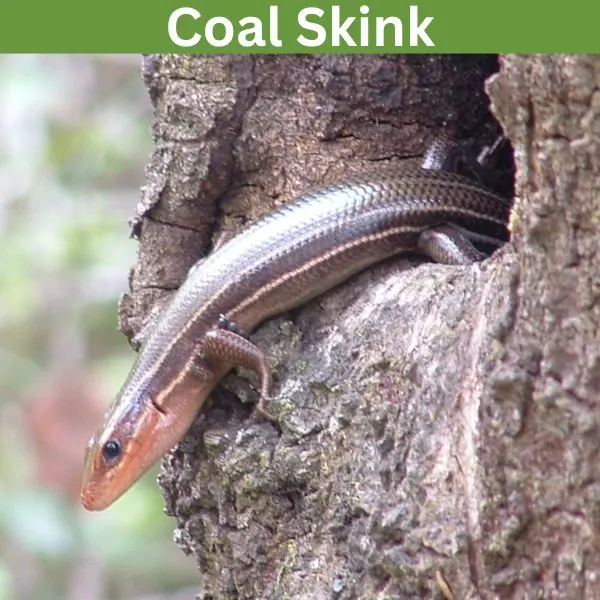
- Experience Level: Intermediate
- Family: Scincidae
- Scientific Name: Plestiodon anthracinus
- Other Names: n/a
- Adult Size: 5.1 to 7.1 in. (13 to 18 cm.)
- Lifespan: 6 years
- Average Price Range: n/a
Coal skinks are native to Florida, and the eastern United States. This lizard lives only in a small corner of western Florida. Coal skinks live in moist forests and other vegetated habitats near streams. Their overall population across America is scattered.
Coal skinks are medium-sized. They have short legs and a slender body. Tan, gray, or black are the colors this lizard appears in. They have stripes on their sides and a shiny appearance.
Spiders, and invertebrates in the ground are what this lizard eats. They lay their eggs in the soil, and stay with them until they hatch. Coal skinks are not very common, and are hard to study due to their limited range, and population.
22. Mole Skink
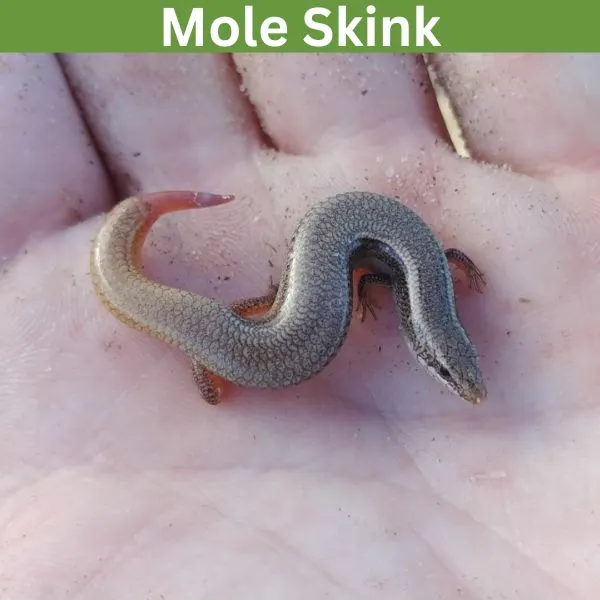
- Experience Level: Intermedate
- Family: Scincidae
- Scientific Name: Plestiodon egregius
- Other Names: n/a
- Adult Size: 3.5 to 6 in. (9 to 15 cm.)
- Lifespan: n/a
- Average Price Range: n/a
The mole skink is a native species to Florida. This lizard lives in most of the state and inhabits sandhills and scrub habitats. Mole skinks are burrowers, and may not be seen because of their secretive nature. Mole skinks get their name from their ability to dig like a mole.
There are around five subspecies of mole skink that live in Florida. These include the Peninsula mole skink (P. e. onocrepis), the Florida Keys mole skink (P. e. egregius), the Cedar Key mole skink (P. e. insularis), the bluetail mole skink (P. e. lividus), and the northern mole skink (P. e. similis). These lizard subspecies are very similar and can usually be told apart by where they are found, or minor differences.
Mole skinks are small, with brown coloring. They have a stripe on their side and blue tails. This species spends its time feeding in the soil it lives in. Some subspecies of mole skink in Florida are protected and are in need of conservation.
23. Common Five-lined Skink
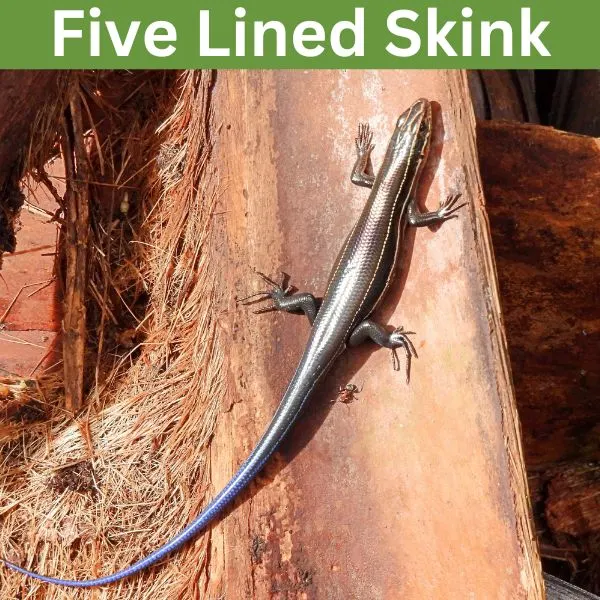
- Experience Level: Intermediate
- Family: Scincidae
- Scientific Name: Plestiodon fasciatus
- Other Names: American five-lined skink
- Adult Size: 4.9 to 8.5 in. (12.5 to 21.5 cm)
- Lifespan: 6 years
- Average Price Range: $12
Common five-lined skinks are found in the southeastern United States. This lizard in Florida is found in the eastern half of the state. Common five-lined skinks live in moist hardwood habitats. They often live next to streams, and other water sources.
Common five-lined skinks are medium-sized. They have olive, gray, or tan coloring with five stripes running down their body. This species has tan to yellowish stripes on them. When young their tails are blue, and in the breeding season their faces have red markings.
A very common species, this skink breeds in the summer and falls. They can be very territorial. Common five-lined skinks are extremely wary and have antipredator behaviors to help them survive animals like birds, snakes, and small mammals.
24. Southeastern Five-lined Skink
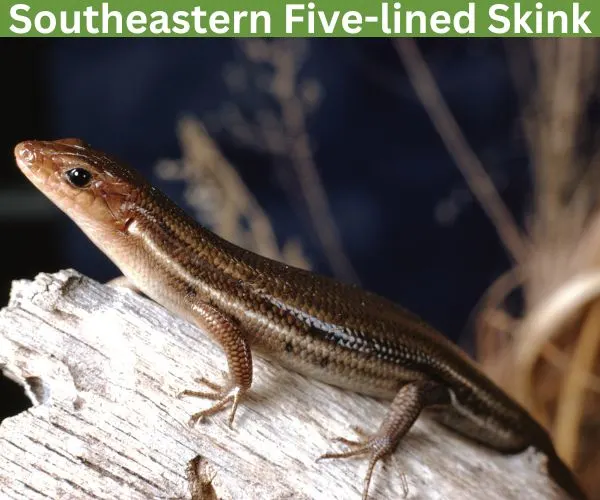
- Experience Level: Beginner
- Family: Scincidae
- Scientific Name: Plestiodon inexpectatus
- Other Names: n/a
- Adult Size: 5.5 to 8.5 in. (13.97 to 21.59 cm.)
- Lifespan: 6 years
- Average Price Range: n/a
The southeastern five-lined skink is native to the eastern United States. This lizard can be found all across Florida. Dry woodlands and pine habitats near coastal regions are where these lizards are common.
Southeastern five-lined skinks when born have bright blue tails. As this lizard ages their blue tail may go away. Tan, olive, or black are the colors of this lizard. Around 5 tan stripes run down their body.
This skink lay their eggs in moist places during the summer and stays with them until they hatch. Southeastern five-lined skinks feed on small invertebrates. They are active on the ground amongst vegetation.
25. Broad-headed Skink

- Experience Level: Intermediate
- Family: Scincidae
- Scientific Name: Plestiodon laticeps
- Other Names: Broadhead Skink, Red-headed Scorpion
- Adult Size: 5.9 to 13 in. (15 to 33 cm.)
- Lifespan: 4 to 8 years
- Average Price Range: n/a
The broad-headed skink is native to the southeastern United States. This species is found in the northern half of Florida. Broad-headed skinks live in oak woods and other woodland habitats with lots of trees. As a very arboreal lizard, this species is often seen in trees.
Broad-headed skinks that are male have very large, and wide heads. Tan, or olive green color is how this species looks. The head of this lizard has a shade of reddish. Females have stripes and them.
Insects and various other invertebrates are what the broad-headed skink eats. You may find this lizard hiding under logs or rocks. To help sense prey reptiles like this will flick out their tongues to enhance their senses. Broad-headed skinks have a large range across the United States and a stable population.
26. Florida Sand Skink

- Experience Level: Advanced
- Family: Scincidae
- Scientific Name: Plestiodon reynoldsi
- Other Names: n/a
- Adult Size: 4 to 5 in. (10 to 13 cm.)
- Lifespan: 15 years
- Average Price Range: n/a
The Florida sand skink is found in Central Florida. This species is native to the state and lives in scrub, oak, and flatwoods habitat. This species prefers moist areas with lots of vegetation. Florida sand skinks are considered a vulnerable species and are losing their population due to habitat protection.
Florida sand skinks have an elongated body, with a shape like a snake. Their limbs are extremely tiny and only have small digits. This species has gray, or tan coloring. Their eyes are small, and have a transparent lower lid which helps them move through dirt.
The diet of this lizard is made up of termites, spiders, beetles, and other invertebrate. The spring is when these lizard mates and their eggs hatch in the fall. The various invasive lizards in Florida are why the native Florida sand skink is becoming endangered.
27. Little Brown Skink
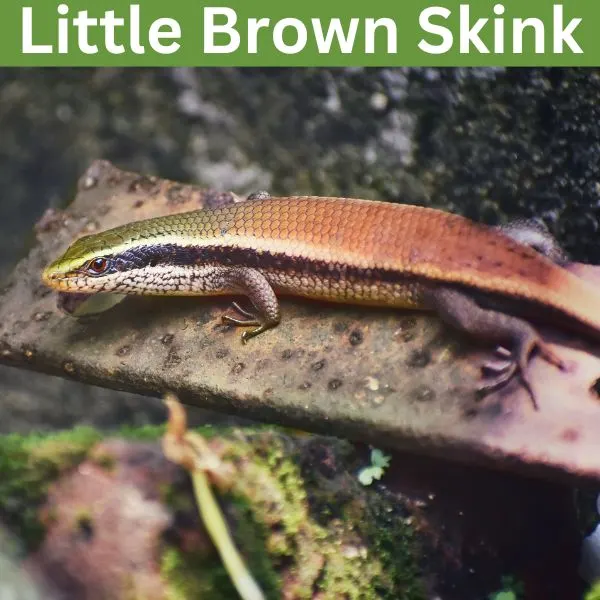
- Experience Level: Beginner
- Family: Scincidae
- Scientific Name: Scincella lateralis
- Other Names: Ground Skink, Brown-backed Skink
- Adult Size: 3 to 5.25 in. (7.62 to 13.3 cm.)
- Lifespan: 2.5 years
- Average Price Range: $5
Little brown skinks have a range covering all of Florida. This lizard is native to the southeastern United States. Forest habitats are where this species is common, and some call this species the “ground skink” since they are regularly found on the forest floor. Gardens, urban habitats, and other places with loose soil are where this lizard is regularly found.
The size of the little brown skink is very small. They have a slender, worm-like body, with very small legs. This species has tan or grayish coloring. A bold dark stripe runs down the side of their body.
Earthworms, spiders, insects, and other small invertebrates found in soil are what this lizard eats. Birds, snakes, and small mammals are this species’ predators. Little brown skinks are very common, and have a stable population in the state.
28. African Five-lined Skink

- Experience Level: Intermediate
- Family: Scincidae
- Scientific Name: Trachylepis quinquetaeniata
- Other Names: Rainbow Mabuya
- Adult Size: 7.9 in. (20 cm.)
- Lifespan: 6 years
- Average Price Range: $10
The African five-lined skink lives in Egypt and the southern parts of Africa. They are one of the many types of skinks invasive in Florida. Grasslands and rocky habitats are where you may find this lizard.
African five-lined skinks are medium-sized. They have olive, or brown coloring, with spots, and brown stripes on them. Their tails are blue, and their colors may change to become less prominent as they age. The scales of this lizard are roughly keeled.
The reptile trade, and people releasing this lizard, or losing them is why the African five-lined skink has managed to build a population in Florida. Trees are where these lizards live, but they sometimes go on man-made structures. Insects, butterflies, and ants are what this lizard eats.
29. Common Sun Skink

- Experience Level: Intermediate
- Family: Scincidae
- Scientific Name: Eutropis multifasciata
- Other Names: Many-striped Skink, Common Sun Skink
- Adult Size: 13.7 in. (35 cm)
- Lifespan: n/a
- Average Price Range: n/a
The brown mabuya is a species of skink found in India and Asia. This lizard has become invasive in several regions of the world, including Florida. Forest habitats are where this lizard lives, and they are terrestrial species.
Brown mabuya lizards have tan or olive coloring. They have yellowish, or white coloring on their sides and bellies. Their scales aver very shinily, and their toes are long.
This lizard competes with the native skinks in Florida. They mainly feed on smaller insects. They are not seen often and are extremely rare.
Chamaeleonidae
30. Veiled Chameleon

- Experience Level: Advanced
- Family: Chamaeleonidae
- Scientific Name: Chamaeleo calyptratus
- Other Names: Yemen Chameleon
- Adult Size: 17 to 24 in. (43 to 61 cm.)
- Lifespan: 6 to 8 years
- Average Price Range: $50
The veiled chameleon is a species native to Yemen, and Saudi Arabia. This lizard lives in coastlands and moist habitats with lots of vegetation. Veiled chameleons can be found in urban, and suburban areas. This species is the most widespread invasive chameleon in the state and was introduced to the region in the early 2000s.
Veiled chameleons have the bright coloring of green, orange, turquoise, yellow, and black. They can have stripes on them, and a blotched pattern. These lizards have large crests on their head. Special feet that have special toes help this lizard grip and climb.
Insects are what this lizard eats, and this species is active during the day. Their lives are spent in trees, and other vegetation looking for food.
31. Oustalet’s Chameleon

- Experience Level: Advanced
- Family: Chamaeleonidae
- Scientific Name: Furcifer oustaleti
- Other Names: Malagasy Giant Chameleon
- Adult Size: 12 to 27 in. (30.5 to 68.5 cm)
- Lifespan: 10 years
- Average Price Range: $100
Madagascar is where the Oustalet’s chameleon is native to. This species lives in forests and urban habitats with lots of trees. This lizard is one of the few invasive chameleon species in Florida and has a breeding population.
Oustalet’s chameleons are the largest chameleon species. This lizard is able to change its color, but they are usually green. A crest appears on this lizard’s head, and they can have a banded pattern on them.
Invertebrates like small insects and even small animals like birds are what this lizard eats. This species feeds on fruit, and other plat life as well. They have a strong tongues they flick out quickly to catch prey.
32. Panther Chameleon

- Experience Level: Intermediate
- Family: Chamaeleonidae
- Scientific Name: Furcifer pardalis
- Other Names: n/a
- Adult Size: 14 to 21 in. (36 to 53 in.)
- Lifespan: 5 to 7 years
- Average Price Range: $450
Panther chameleons are native to Madagascar. This lizard lives in rainforests and savanna habitats. They have become invasive to Florida and are one of the most common chameleons kept as pets. This species is loved for its amazing color and unique appearance.
Panther chameleons that are male have more vibrant colors. This species has five toes, placed in groups of twos, which help them have a tight grip. They have a long, and strong tongue used to catch prey. Chameleons have bulging eyes, that let them see in multiple directions.
Panther chameleons when breeding can be very territorial. This lizard can lay between 10 to 40 eggs in a clutch. They are short-lived animals, and females die more quickly since they constantly lay eggs.
Gekkonidae
33. Ba Den Golden Gecko

- Experience Level: Intermediate
- Family: Gekkonidae
- Scientific Name: Gekko badenii
- Other Names: Baden’s Pacific Gecko
- Adult Size: 7 to 8 in. (18 to 20 cm.)
- Lifespan: 8 years
- Average Price Range: $17
Golden geckos are native to Vietnam. They live in rainforest habitats up to 3,235 ft. above sea level. These lizards have also managed to become invasive to Florida. They live in rock habitats with lots of trees near the water.
Golden geckos are named after their golden hue. They are medium-sized and have smooth, wrinkly skin. This lizard has knobs near the end of their tail. Small invertebrates are what this lizard eats. Golden geckos are a very popular species in the pet trade.
34. Tokay Gecko

- Experience Level: Intermediate
- Family: Gekkonidae
- Scientific Name: Gekko gecko
- Other Names: n/a
- Adult Size: 8 to 12 in. (20 to 30 cm.)
- Lifespan: 10 years
- Average Price Range: $50
Tokay gecko is native to Asia, and the Pacific islands. This lizard is invasive to Florida and was reported in the state as early as 1965. Rainforests and moist habitats are where this species lives. They are common in urban areas.
Male lizards of this species are larger and also have brighter colors. This species has yellow, gray, green, or blue coloring. They have a mottled pattern. Their eyes are large and yellow, with elliptical pupils. This lizard has a large head, with a big mouth.
Tokay geckos are active at night and use their time looking for food. Geckos like this species are very territorial, and if threatened may bite. This lizard feeds on insects and small invertebrates like roaches. When breeding you can hear this lizard using a mating call to attract a partner.
35. Yellow-headed Gecko

- Experience Level: Intermediate
- Family: Gekkonidae
- Scientific Name: Gonatodes albogularis
- Other Names: White-throated clawed Gecko
- Adult Size: 2.7 to 3.5 in. (6.9 to 9 cm.)
- Lifespan: 5 to 10 years
- Average Price Range: n/a
The yellow-headed gecko is native to Central and South America. This species has become invasive in several regions around the world, including Florida. This gecko lives in humid, and tropical habitats. They enjoy climbing and are regularly seen on fences and trees.
The name of this gecko comes from its yellowish, or orange head. They have grayish, or white bodies, with speckled patterns on them and bumpy skin. Blue coloring can sometimes appear on them.
Yellow-headed geckos are able to lose their tail if attacked and will grow them back. This lizard is sometimes found indoors but spends most of its life outside looking for small insects to eat. This gecko is active during the day and can be seen basking in the sun with others. Yellow-headed geckos have lived in Florida for more than 60 years, and are a rare lizard to find.
36. Common House Gecko

- Experience Level: Intermediate
- Family: Gekkonidae
- Scientific Name: Hemidactylus frenatus
- Other Names: Pacific House Gecko, Moon Lizard
- Adult Size: 3 to 6 in. (7.5 to 15 cm.)
- Lifespan: 5 years
- Average Price Range: n/a
Common house geckos are native to Asia, and are an introduced species to Florida. This lizard is common in urban areas and is active at night. They hunt for small insects to feed on and prefer places with light. This lizard is common near homes and hunts on walls.
This species is medium-sized and pinkish to gray in color. They have white undersides and may have a mottled pattern on them. They have an elongated snout and tail, with bumpy skin.
Common house geckos are aggressive and may bite if provoked. They hide under debris like logs, or rocks when not active. This species is common in humid areas, in warm weather. Common house geckos are not harmful to humans and are often seen near our homes.
37. Indo-Pacific House Gecko

- Experience Level: Intermediate
- Family: Gekkonidae
- Scientific Name: Hemidactylus garnotii
- Other Names: Assam Greyish Brown Gecko
- Adult Size: 4 to 5 in. (10 to 13 cm)
- Lifespan: 5 years
- Average Price Range: n/a
Southeast Asia is where the Indo-Pacific house gecko is native to. This species lives in tropical urban areas around the globe and is one lizard considered invasive in Florida. This species is a threat to other animals, their resources, and their territory.
The Indo-pacific house gecko is gray to brown. They have smooth skin, with yellow cat-like eyes. This lizard looks similar to other geckos but can be told apart by its smooth skin.
When breeding this lizard lays its eggs in moist areas like under bark. This species is able to vocalize and can make noises. Being so territorial makes this lizard a threat to other geckos in Florida.
38. Tropical House Gecko

- Experience Level: Intermediate
- Family: Gekkonidae
- Scientific Name: Hemidactylus mabouia
- Other Names: Cosmopolitan House Gecko
- Adult Size: 5 in. (12.7 cm.)
- Lifespan: 3 to 5 years
- Average Price Range: n/a
Tropical house geckos are native to Africa. These lizards are found in urban areas and have managed to become invasive to Florida. Tropical House geckos live near forests and sandy areas. They are not seen often and are active at night.
Tropical house geckos have grey, to dark brown coloring. They have bands covering them, and a very slender appearance. Geckos like this species have yellow eyes with elliptical pupils. Their tails are long with bands on them.
Insects are what this gecko eats, and they have excellent climbing due to their toe pads. This lizard is attracted to light sources since that attracts insects. These geckos get eaten by larger lizards, spiders, snakes, and birds.
39. Asian Flat-tailed House Gecko

- Experience Level: Begginer
- Family: Gekkonidae
- Scientific Name: Hemidactylus platyurus
- Other Names: Frilled House Gecko
- Adult Size: 4 to 5 in. (10 to 13 cm.)
- Lifespan: 5 years
- Average Price Range: n/a
The Asian flat-tailed gecko is native to southern Asia. This species is invasive in Florida and has managed to go to new regions due to the pet trade. Urban areas near houses are common places to find this lizard.
The flat tail and loose skin can help identify this gecko. This species has gray, to tan coloring, with dark brown stripes on them. Asian flat-tail geckos have webbed toes, and a pointed head.
Insect prey is what this species eats most. They are preyed on by snakes and larger lizards. Their population in Florida is small, and they are not seen often.
40. Mediterranean House Gecko
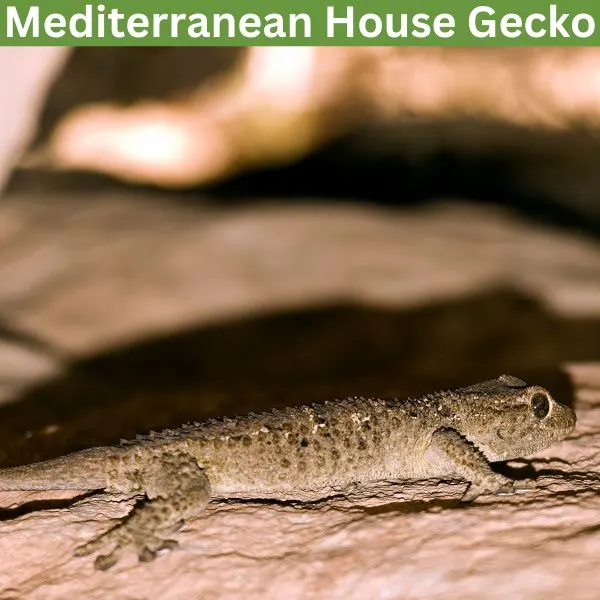
- Experience Level: Beginners
- Family: Gekkonidae
- Scientific Name: Hemidactylus turcicus
- Other Names: Moon Lizard, Turkish Gecko
- Adult Size: 4 to 5 in. (10 to 13 cm.)
- Lifespan: 3 to 9 years
- Average Price Range: $10
Mediterranean house geckos are native to Europe, and the Mediterranean. This lizard is invasive to many regions of the United States, including Florida. Marshes, rocky areas, urban areas, and caves are places this lizard lives.
This species has tan to purple colored skin. They have large yellow eyes, with cat-like pupils. The skin of this gecko is very bumpy. They have spots and a mottled pattern on them.
Mediterranean house geckos are active at night and spend their time feeding on insects. This species gets preyed on by larger spiders, lizards, birds, and small rodents.
41. Mourning Gecko

- Experience Level: Intermediate
- Family: Gekkonidae
- Scientific Name: Lepidodactylus lugubris
- Other Names: Common Smooth-scaled Gecko
- Adult Size: 3.3 to 3.9 in. (8.5 to 10 cm)
- Lifespan: 10 to 15 years
- Average Price Range: $40
Not native to Florida, the Mourning gecko is a species found in coastal regions in places around the world. This lizard is native to southeastern Asia. Mourning geckos are an all-female species. They are able to reproduce without males and can make two eggs a year.
Mourning geckos are small, and nimble lizards. They have tan, yellow, and black coloring with a mottled pattern. Unlike other reptiles, this lizard has a smooth look.
Some people keep the mourning gecko as a pet, but certain terrarium conditions must be met for them to survive. Small spiders, insects, nectar and fruit are what this lizard eats.
Anguidae
42. Eastern Slender Glass Lizard

- Experience Level: Intermediate
- Family: Anguidae
- Scientific Name: Ophisaurus attenuatus longicaudus
- Other Names: n/a
- Adult Size: 22 to 46 in. (55.88 to 116.84 cm.)
- Lifespan: 10 to 30 years
- Average Price Range: $50
The eastern slender glass lizard is found all over Florida and is native to the southeastern United States. This lizard lives in the Coastal Plains regions, preferring sandy habitats. This lizard is considered vulnerable in several states within its range, mainly due to habitat loss.
The long body of the eastern slender glass lizard is legless, and tan. They have a mid-dorsal stripe on their back, with specks that appear on them. Males of this size are longer and also have bigger heads.
Eastern slender glass lizards are active during the day. Their speed makes them hard to find, and they even hide in hard to get to places. The months from October until April is when glass lizards are not seen, and hibernate during the cold. Glass lizards feed on insects, spiders, small rodents, and snails, but do not have flexible jaws like snakes.
43. Island Glass Lizard

- Experience Level: Intermediate
- Family: Anguidae
- Scientific Name: Ophisaurus compressus
- Other Names: n/a
- Adult Size: 15 to 24 in. (38 to 61 cm.)
- Lifespan: 10 to 30 years
- Average Price Range: $50
Island glass lizards are native to Florida, as well as Georgia and southeastern South Carolina. This lizard lives in sandy scrub and dry sandy habitats. They are regularly found on offshore islands, which is where they get their name.
The slender, legless body of this lizard has brown, or yellowish coloring. They have a string stripe running down the side of the body, and a dark mottled pattern covering them. Their heads are narrow, and tail long.
Island glass lizards are very secretive, and not much is known about their overall range. The day is when this lizard forages, but they also regularly hide under debris like larger rocks, or logs.
44. Mimic Glass Lizard
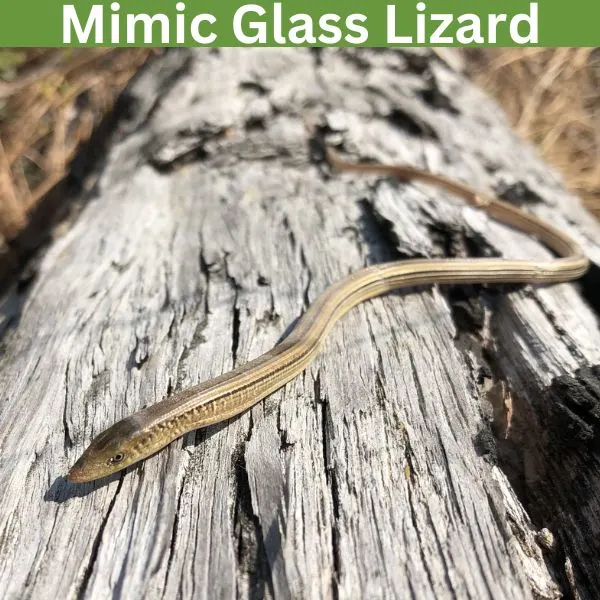
- Experience Level: Intermediate
- Family: Anguidae
- Scientific Name: Ophisaurus mimicus
- Other Names: n/a
- Adult Size: 15 to 26 in. ( 38 to 66 cm.)
- Lifespan: 10 to 30 years
- Average Price Range: $50
The Mimic glass lizard range is very small, and they are native to the coastal states from southern Georgia to South Carolina. This lizard lives in the western and northern corners of Florida. Longleaf pine flat woods in dry places are where this snake-like lizard prefers to live.
Mimic glass lizards are slender, with no legs, or arms. They have a jaw that is not flexible despite looking like a snake. Brown to yellow is the color this lizard appears in, and they have several dark stripes running down the sides of their body.
Mimic glass lizards are native to the state of Florida but are rarely seen since they live in such a small region within the state. This lizard is able to drop its tail if stressed, which will grow back with time. Summer is when this lizard lays its eggs, but the small amount of glass lizards makes them a difficult species to study.
45. Eastern Glass Lizard
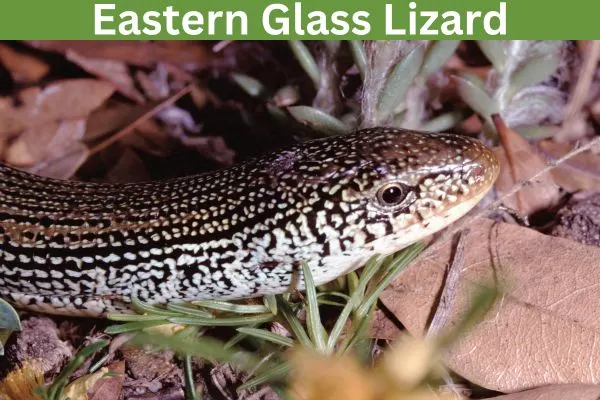
- Experience Level: Intermediate
- Family: Anguidae
- Scientific Name: Ophisaurus ventralis
- Other Names: n/a
- Adult Size: 18 to 43 in. (46 to 108 cm.)
- Lifespan: 10 to 30 years
- Average Price Range: $50
The eastern glass lizard is found all over Florida. This lizard is native to the state, and the far southeastern United States. Eastern glass lizards live in wetlands, and other similar habitats with moist, sandy soil. The coastal plains of the United States are where this lizard is restricted to.
Eastern glass lizards have slender and snake-like bodies. Greenish or yellow with a mottled dark pattern is what covers this lizard. Unlike snakes, glass lizards have blinkable eyes and earholes.
The teeth of the eastern glass lizard are grooved and used to feed on insects like grasshoppers, and beetles. Some common predators this species faces include foxes, skunks, and snakes. The limited range and secretive nature of the glass lizard is why they are so rare.
46. Madagascar Giant Day Gecko

- Experience Level: Intermediate
- Family: Gekkonidae
- Scientific Name: Phelsuma grandis
- Other Names: n/a
- Adult Size: 9 to 11 in. (23 to 28 cm.)
- Lifespan: 15 years
- Average Price Range: $80
The Madagascar giant day gecko is native to Madagascar. This lizard is introduced to Florida and Hawaii. They live in tropical habitats with lots of trees and are active during the day. Madagascar giant day geckos are sometimes kept and sold as exotic pets, which is why they can become invasive.
This lizard has bright brown, or blue coloring. They have reddish spots, and a stripe on their body. Yellowish color also appears on this lizard. Covering them are very granular, and bumpy scales.
Madagascar giant day geckos feed on insects and invertebrates and on small occasions small vertebrates. This lizard also enjoys eating sweet fruit and nectar. Madagascar giant day geckos have a stable population and can be a threat to the native lizards in Florida because of their size.
47. Gold Dust Day Gecko

- Experience Level: Intermediate
- Family: Gekkonidae
- Scientific Name: Phelsuma laticauda
- Other Names: n/a
- Adult Size: 3.9 to 5.1 in. (10 to 13 cm.)
- Lifespan: 15 years
- Average Price Range: $80
Gold dust day geckos are native to northern Madagascar, and other islands nearby. This lizard is one that has been introduced to Florida, Hawaii, and other similar places. Gold dust day geckos live in urban, and other habitats that have lots of trees. They enjoy climbing and are active during the day.
This species is famous for being used as a mascot for Geico Insurance. They have a bright green or yellowish color. They have specks on them and yellow, and orange markings. Their green may sometimes have a bluish hue in places like on their hands.
Insects, smaller lizards, and other things they can fit into their mouth are what this species eats. These lizards can be very aggressive, and territorial with other lizards. Females can lay up to 12 eggs, which take around a month to hatch. With the ability to live 15 years, this lizard is considered an invasive threat in Florida.
Sphaerodactylidae
48. Ocellated Gecko

- Experience Level: Beginner
- Family: Sphaerodactylidae
- Scientific Name: Sphaerodactylus argus
- Other Names: n/a
- Adult Size: 2.3 to 2.4 in. (5.8 to 6.09 cm.)
- Lifespan: 10 to 20 years
- Average Price Range: $150
The Carribeans in places like Jamaica, and Cuba is where the Ocellated Gecko is native to. This species has managed to establish populations in the Florida Keys. Forest habitats are where this lizard prefers to live, and they live at elevations up to 330 ft. They live in leaf litter and dirt.
This gecko species is very small, which includes their small feet and toe pads. This lizard is olive or brown in color. They have small spots covering them. Ocellated geckos are extremely rare, and not seen often because of their small size.
Because of how rare the Ocellated gecko is studying this lizard is difficult. Likely this species does not compete with other similar gecko species like the ashy Gecko, or reef gecko since their range in Florida is extremely limited.
49. Ashy Gecko

- Experience Level: Beginner
- Family: Sphaerodactylidae
- Scientific Name: Sphaerodactylus elegans
- Other Names: Ashy Sphaero
- Adult Size: 2.7 to 2.8 in. (6.8 to 7.1 cm.)
- Lifespan: 10 to 20 years
- Average Price Range: $35
The ashy gecko is a species native to Cuba. This lizard is very small and has managed to establish populations on far southern islands of the state. This lizard first occurred in the state in 1922. They primarily inhabit the lower Florida Keys region.
Ashy geckos have stripes on their body, with red or blue tails. The bands that run across this lizard’s body are dark, and their overall color is greenish or gray. Ashy geckos are sometimes kept as pets and kept in a small terrarium. Ashy geckos need specific humid, and warm environments for them to survive.
50. Reef Gecko

- Experience Level Intermediate
- Family: Sphaerodactylidae
- Scientific Name: Sphaerodactylus notatus
- Other Names: Brown-speckled Sphaero
- Adult Size: 2 to 2.25 in. (5.1 to 5.7 cm.)
- Lifespan: 10 to 20 years
- Average Price Range: $40
The reef gecko is a native species to Florida, and also the Caribbean. This species is found in southeastern and mainland Florida. They live in pinelands, hammocks, and even urban habitats . They are often found hiding under rocks, logs, and vegetation.
Reef geckos are tiny, and have a tannish to brown coloring. They have a mottled pattern covering them. The head of this lizard is small and pointed, and its limbs are nimble.
The reef gecko is one of the few gecko species native to the United States. There are some theories that this species can go to the United States on boats. This lizard was first reported in the U.S. in the 1800s. They feed on small insects and invertebrates.
Phyllodactylidae
51. Ring Wall Gecko

- Experience Level: Intermediate
- Family: Phyllodactylidae
- Scientific Name: Tarentola annularis
- Other Names: White-spotted Wall Gecko
- Adult Size: 7 to 8 inches. (17.8 to 20.3 cm.)
- Lifespan: 15 years
- Average Price Range: $75
The ring wall gecko is native to northern Africa but has managed to establish itself in Florida. This species is active in urban habitats, and is nocturnal. They make squeaking noises, and if handled may bite. This lizard species has also been introduced to other parts of the United States like California and Arizona.
The ring wall lizard is a gray, or tan species. They have a pointed head, flat body, and pads on their toes. This lizard has white spots on their backs and elliptical eyes. Male ring wall lizards have large and also have bigger heads.
Ring wall lizards feed on insects, and do their hunting at night. This lizard is invasive and can feed on small animals, or even other lizards.
52. Moorish Gecko

- Experience Level: Intermediate
- Family: Phyllodactylidae
- Scientific Name: Tarentola mauritanica
- Other Names: Crocodile Gecko, Common Wall Gecko
- Adult Size: 5.9 in. (15 cm.)
- Lifespan: 15 years
- Average Price Range: $30
The Moorish Gecko is a species native to North Africa, and Europe in the western Mediterranean. They are a lizard introduced to many regions of the world including Florida. Dry, and rocky habitats are where this lizard lives.
Moorish geckos have brown, beige, or gray coloring. At night this species has darker colorings. They have a very bumpy appearance which is helpful in helping them camouflage.
Moorish geckos are active at night, but sometimes during the day. This species feeds on insects and stays near lights. They can also feed on smaller frogs, and lizards, which is why invasive animals like this can be an issue.
Phrynosomatidae
53. Texas Horned Lizard
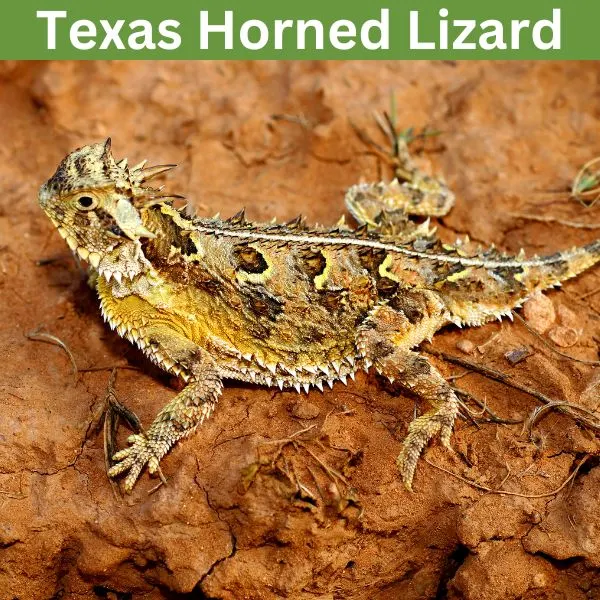
- Experience Level: Advanced
- Family: Phrynosomatidae
- Scientific Name: Phrynosoma cornutum
- Other Names: Horny Toad
- Adult Size: 3.7 to 5 in. (9.93 ot 12.7 cm.)
- Lifespan: 5 years
- Average Price Range: $40
The Texas horned lizard is native to the south-central United States. This lizard has been introduced to several new places, including Florida. Scrub and semi-arid habitats are where this lizard lives. They are active in the day, and may not be seen since they easily blend into dry vegetation.
Texas horned lizards are covered in several horns, including some of their head. This lizard has a tan, to grayish coloring, with a mottled pattern covering it. They have a round body, and the spikes on them help ward off predators.
The pet trade is the reason why the Texas horned lizard has been introduced to many new regions. Texas horned lizards feed on insects. They are known for being able to squirt blood out of their eyes, which can help get rid of dogs.
Iguanidae
54. Mexican Spinytail Iguana

- Experience Level: Intermediate
- Family: Iguanidae
- Scientific Name: Ctenosaurua pectinata
- Other Names: Western Spiny-tailed Iguana
- Adult Size: 4.3 ft. (1.3 m.)
- Lifespan: 60 years
- Average Price Range: $50
Native to Mexico, Florida is an area where the Mexican spiny tail iguana has been introduced. This lizard is able to live in groups, or alone. They enjoy rocky habitats with lots of trees for them to climb. This lizard has a stable population in Mexico. Females can lay up to 50 eggs in a burrow, and hatchlings emerge in the summer and fall months.
Mexican spiny tail iguanas have keeled scales with long tails. They have brown, or gray coloring, with a crest on their spine. When born this lizard has bright green, and they darken with age. Bands and dark stripes appear on this lizard’s tail.
Mexican spiny tail iguanas are active during the day. They feed on flowers, leaves, and fruits mostly, but sometimes feed on eggs and small animals. This invasive lizard can be dangerous to Florida since it can eat ground-nesting birds, and compete with native species in the state.
55. Black Spinytail Iguana

- Experience Level: Intermediate
- Family: Iguanidae
- Scientific Name: Ctenosaura similis
- Other Names: Black Iguana
- Adult Size: 2.7 to 3.3 ft. (0.1 to 1 meter)
- Lifespan: 60 years
The black spiny tail iguana is an invasive species that has been found in Floridas coast, as well as the central and southern regions of the state. Dry, and moist woodland and savanna habitats are where this lizard lives. Mexico and Central America are where this lizard is native.
Black spinytail iguanas have greyish coloring, with black stripes on them. They have a crest on their spine and have black coloring on their feet. This lizard is very large, and their tails are extremely keeled, which is where their name comes from.
This iguana likes climbing rocks, and trees, as well as basking in the sun. They mainly feed on plants and fruit, but can sometimes feed on small animals. This lizard is extremely quick and able to run around 21.5 mph. (34.6 kph).
56. Green Iguana

- Experience Level: Advanced
- Family: Iguanidae
- Scientific Name: Iguana iguana
- Other Names: Green Iguana
- Adult Size: 5.6 to 6.6 ft. (1.7 to 2 meters)
- Lifespan: 20 years
- Average Price Range: $40
Green iguanas are native to Brazil and Paraguay, all the way to Mexico. This lizard is invasive to Florida, and if spotted in the state it should be reported. Urban areas and agricultural areas with lots of vegetation are where the green iguana lives. They are great swimmers, and capable of staying underwater for up to 4 hours.
Green iguanas are very large, with green, black, or brown coloring. They are bright green when young. Their spine, head, and tails have a creat of them, and their face has large scales. Dark bands sometimes cover this lizard.
It is common for people to buy green iguanas as pets, then release them into the wild since they are difficult pets. Green iguanas feed on vegetation, like fruits, flowers, and vegetables.
Leiocephalidae
57. Northern Curlytail Lizard

- Experience Level: Intermediate
- Family: Leiocephalidae
- Scientific Name: Leiocephalus carinatus
- Other Names: Saw-scaled Curlytail
- Adult Size: 4.1 in. (10.5 cm.)
- Lifespan: 5 to 8 years
- Average Price Range: $10
The Bahamas, Cayman Islands, and Cuba are where the northern curly tail lizard is native. This species was brought to Florida in the 1940s, as a way to control pests in fields. Northern curly tail lizards are terrestrial and burrow when hiding from predators.
This lizard is medium-sized, and is known for its very curly tail.They have tan coloring, with bands, on them. Their scales are very keeled, and they have small, pointed heads.
This lizard is very wary of predators and will attempt to scare them off before they get close. They can also play dead if threatened. Northern curly tail lizards have a stable population, even in areas where introduced.
58. Red-sided Curlytail Lizard

- Experience Level: Intermediate
- Family: Leiocephalidae
- Scientific Name: Leiocephalus schreibersii
- Other Names: Hispaniolan Khaki Curlytail
- Adult Size: 2.9 to 4.2 (7.5 to 10.7 cm)
- Lifespan: 5 to 8 years
- Average Price Range: n/a
The red-sided curly-tail lizard is native to Hispaniola, in the Caribbean. This lizard is one of many that has been introduced to Florida. Shrubland habitats at elevations up to 1,600 ft. are where this lizard lives.
This lizard is a colorful species, with very keeled scales. Reddish and bluish colors appear on their side, and they have yellow coloring on their back. The tail of this lizard is long and has a curl at its end.
Insects and small invertebrates are what this lizard feeds on. They are active during the day and breed by laying eggs like other lizards. Sometimes kept as a pet, this species has a stable population.
Phrynosomatidae
59. Eastern Fence Lizard
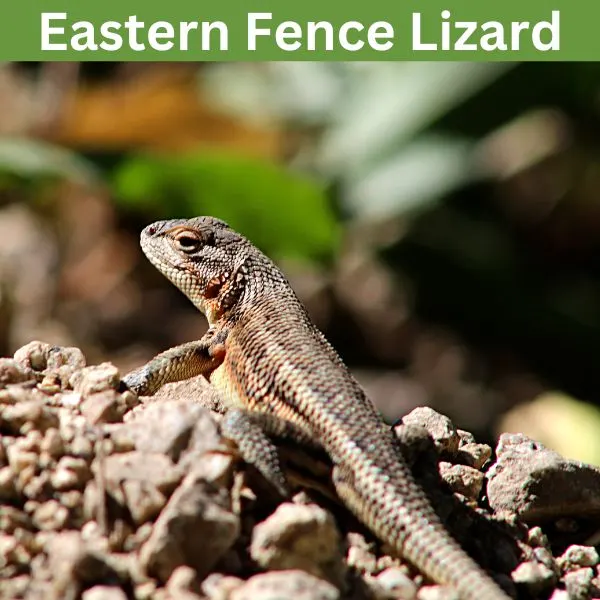
- Experience Level: Intermediate
- Family: Phrynosomatidae
- Scientific Name: Sceloporus undulatus
- Other Names: Prairie lizard, fence swift, pine lizard, gray lizard
- Adult Size: 4 to 7.25 in. (10.16 to 18.41 cm.)
- Lifespan: 4 years
- Average Price Range: $20
Eastern fence lizards are native to the United States. This species is native to the eastern, and southern regions of the U.S. Eastern fence lizards live in grasslands, woodlands, and other habitats with lots of trees. You can find this lizard sitting on fences, and basking in the sun.
Eastern fence lizards have gray, to tan coloring. They have wavy line patterns covering their bask. The scales of this lizard are roughly keeled. Males have blue coloring on their throats and bellies.
In the cold season, the eastern fence lizard is able to survive in the cold until warmer temperatures come. Small insects and animals are what this lizard eats. Breeding season, and out in the day looking for season is when this lizard is this native lizard is spotted in Florida.
60. Florida Scrub Lizard

- Experience Level: Intermediate
- Family: Phrynosomatidae
- Scientific Name: Sceloporus woodi
- Other Names: n/a
- Adult Size: 5 in. (13 cm.)
- Lifespan: 2 to 3 years
- Average Price Range: n/a
The Florida scrub lizard is native to the state of Florida. These species live in sand pine scrub, oak woods, flatwoods, and citrus grove habitats. The Florida scrub lizard is endangered, mainly due to the loss of their habitats. Conservation efforts are being made to stop the fragmentations of their populations.
Florida scrub lizards are a medium-sized species. They have gray, or brown coloring. A stripe appeases on their sides, and specks cover them. Males have a blue turquoise coloring under their chin.
Florida scrub lizards breed in the spring and summer and emerge from their eggs in the fall. Females lay around 2 to 8 eggs. Small insects are what this lizard feeds on. Protecting their habitat is essential in maintaining this Florida native lizards’ presence in the state, as well as decreasing the number of invasive lizards.
Rhineuridae
61. Florida Worm Lizard

- Experience Level: Intermediate
- Family: Rhineuridae
- Scientific Name: Rhineura floridana
- Other Names: Graveyard Snake, Thunderworm
- Adult Size: 7 to 12 in. (18 to 30 cm.)
- Lifespan: n/a
- Average Price Range: n/a
The Florida worm lizard is a native lizard to the state of Florida. This species lives in forests and shrubland habitats. This lizard is a burrowing species and lives in sand, soil, or leaf litter.
Florida worm lizards have a pinkish color and a very slender body. They look like an earthworm and have a shovel snout to help them dig, with no limbs. This lizard has scales covering them.
This species is not a true lizard but is actually an amphisbaenid. They feed on small insects and even actual earthworms. The Florida worm lizard is considered a stable species but is not seen often because of its secretive nature.
Varanidae
62. Nile Monitor

- Experience Level: Advanced
- Family: Varanidae
- Scientific Name: Varanus niloticus
- Other Names: Water Leguaan, African Small-grain Lizard
- Adult Size: 5 to 6.5 ft. (1.5 to 1.98 meters)
- Lifespan: 20 years
- Average Price Range: n/a
The Nile monitor is native to Sub-Saharan Africa, and this lizard is an invasive species in Florida. This lizard has managed to make populations in some counties like Palm Beach, and Lee. Being released pets is one this lizard has managed to make a population in the state. Nile monitors are semi-aquatic and need large habitats too big for most pet owners.
Nile monitors are very large and are one of the largest monitors in the world. These lizards have yellowish, and olive coloring. V markings with sports are patterns that appear on them. Being a monitor, this species walks like a Komodo dragon and weighs around 15 lbs.
Fish, meat, fruit, rodents, insects, birds, and other smaller reptiles are what the Nile monitor eats. They are a generalist feeder, and have a large tail they can use as a whip if provoked. This species’ size, and how it takes resources from other lizards is why they are considered invasive.
FAQ
Why does Florida have so many invasive lizards?
The sub-tropical environment in Florida is why so many invasive lizards are able to live in Florida, even if their native home is somewhere across the globe. The pet trade is one of the main reasons why so many lizards get transported to new areas. Pets that are released in the wild can cause a population to form if the circumstances are right.
How many native lizard species live in Florida?
There are around 21 native lizard species that live in Florida. The state has a diverse range of ecosystems, some of which like woodlands, marshes, scrub, and fields make perfect homes for various lizard species.
Are there dangerous lizards in Florida?
There are no poisonous or venomous lizards that live in Florida. The most dangerous types of lizards in Florida are the invasive ones since they can cause an imbalance in the natural ecosystem. Lizards when handled can also spread dangerous germs like salmonella, which is why you should wash your hands if you touch them.
Overall, humans are more dangerous to lizards than they are to us. Larger invasive lizards like the Nile monitor can be dangerous if you provoke, and try to handle them.
Wrapping up
There are around 62 species of lizards you may find in Florida. Surprisingly there are numerous species that get brought in from different areas of the world and become invasive in the state. Some invasive species do not have a breeding population, while others have managed to make themselves a part of the Florida’s ecosystem.
Knowing the lizards in Florida is useful in helping you identify the native, and non-native species. Some lizards make good pets, but you should research the species fully you plan to get. There are reptiles as large as Alligators in Florida, but lizards contain the most diversity. Lizards are amazing animals, with endless interesting things to learn about.
Lizards in other nearby states
